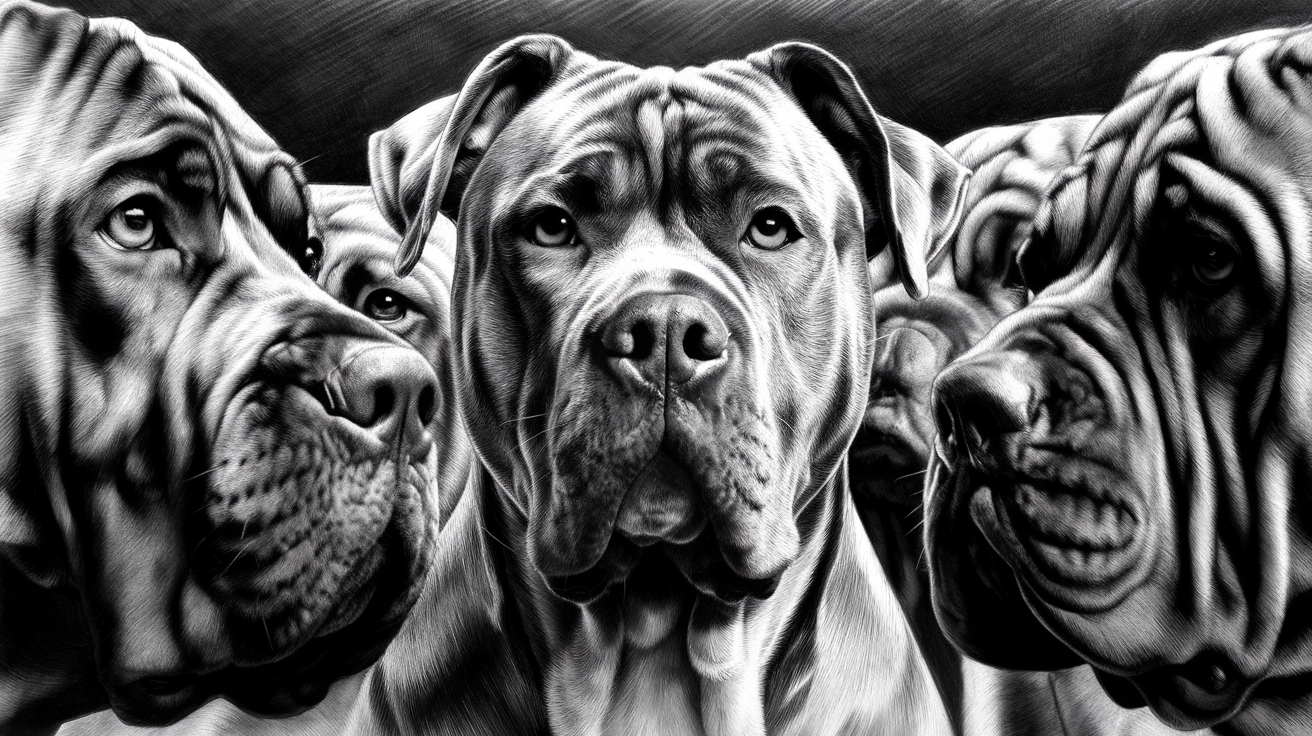Introduction
The Cane Corso, an Italian mastiff, is often compared to other mastiff-type breeds such as the Neapolitan Mastiff, English Mastiff, and Bullmastiff. Although they all share common ancestors, each breed has developed unique characteristics over the centuries. This article delves into the differences between Cane Corso and other mastiffs, focusing on size, temperament, exercise needs, and historical roles.
In this guide, you’ll learn how the Cane Corso stands apart from its fellow mastiffs, helping you make an informed decision if you are considering one of these powerful dogs as a companion or working partner.
Cane Corso vs. Other Mastiffs: Physical Differences

Size and Build
When comparing the Cane Corso to other mastiffs, one of the most evident differences is in their size and build. While all these dogs are large and muscular, the Cane Corso is more athletic, while the Neapolitan and English Mastiffs are bulkier.
- Cane Corso: Weighs between 85-110 pounds (38-50 kg) and stands 23-28 inches (58-71 cm) tall. The Cane Corso is more athletic and lean, built for agility and speed.
Image: Cane Corso demonstrating its lean, athletic build. - Neapolitan Mastiff: Heavier, with a weight range of 110-150 pounds (50-68 kg) and a height of 24-32 inches (61-81 cm). The Neapolitan Mastiff is known for its massive frame, loose skin, and deep wrinkles.
Image: Neapolitan Mastiff with its characteristic loose skin and bulkier frame. - English Mastiff: The largest of the group, weighing up to 230 pounds (104 kg) and standing about 30 inches (76 cm) tall. English Mastiffs are stocky and imposing but less athletic than the Cane Corso.
Life Expectancy
Another important difference between these breeds is their life expectancy. Larger breeds tend to have shorter lifespans, and this holds true for mastiffs.
- Cane Corso: Typically lives between 10-11 years, giving them a slightly longer life expectancy compared to other mastiffs.
- Neapolitan Mastiff: Has a shorter lifespan of 8-10 years due to its larger size and predisposition to certain health issues.
Image: Chart comparing the life expectancy of different mastiffs.
Temperament Differences
Mastiff Breeds Comparison
Trait
Cane Corso
Neapolitan Mastiff
English Mastiff
Protective Instincts and Energy Levels
All mastiffs are known for their protective instincts, but the Cane Corso tends to be more active and territorial than its mastiff cousins.
- Cane Corso: Known for being territorial, alert, and protective. This breed was historically used as a war dog, hunter, and guardian, making it highly versatile. It requires 1-2 hours of exercise per day to stay mentally and physically stimulated. Cane Corsos are best suited for experienced dog owners who can provide firm leadership and consistent training.
Image: Cane Corso running during an exercise session. - Neapolitan Mastiff: Despite their imposing size, Neapolitan Mastiffs are generally calmer and more laid-back. They are protective but slower to react compared to the Cane Corso. They require less exercise, needing about 1 hour of moderate activity per day.
Image: Neapolitan Mastiff lounging, showing its calmer temperament. - English Mastiff: Often referred to as a “gentle giant,” the English Mastiff is calm and easygoing. While they are protective, they are typically more relaxed and do not require as much exercise as the Cane Corso.
Exercise Requirements
Cane Corso vs. Neapolitan Mastiff
- Cane Corso: This breed is energetic and requires 1-2 hours of exercise daily. Without sufficient physical activity, they can become bored and destructive.
- Neapolitan Mastiff: They are less energetic and only need around 1 hour of daily exercise. Overexercising a Neapolitan Mastiff can put strain on their joints due to their heavy build.
Historical Roles
Mastiff Breeds: Historical Timeline and Key Traits
Ancient Rome
Ancestor of modern mastiffs used in warfare and as gladiators.
16th Century
Cane Corso used for hunting large game and guarding livestock in Italy.
World War II
English Mastiff population drops to only 14 known dogs in the UK.
1970s
Revival of Cane Corso breed begins after near extinction.
2010
Cane Corso officially recognized by the American Kennel Club (AKC).
Cane Corso
- Weight: 85-110 lbs
- Height: 23-28 inches
- Lifespan: 10-11 years
- Build: Athletic and lean
- Exercise: 1-2 hours daily
- Temperament: Active, alert
Neapolitan Mastiff
- Weight: 110-150 lbs
- Height: 24-32 inches
- Lifespan: 8-10 years
- Build: Massive, loose skin
- Exercise: 1 hour daily
- Temperament: Calm, protective
English Mastiff
- Weight: Up to 230 lbs
- Height: About 30 inches
- Lifespan: 6-10 years
- Build: Stocky, imposing
- Exercise: Moderate
- Temperament: Gentle giant
Cane Corso
The Cane Corso has a rich history of versatility. Historically, it was used for guarding farms, hunting wild boar, and even serving as a war dog. The breed almost went extinct in the 1970s but was saved through selective breeding, and it was officially recognized by the AKC (American Kennel Club) in 2010.
Image: Historical depiction of Cane Corsos used in hunting and guarding.
Neapolitan Mastiff
The Neapolitan Mastiff, with its heavy build and formidable presence, was primarily used as a guardian dog in Southern Italy. Its distinctive loose skin and wrinkles helped protect it during battles with intruders or wild animals.
Image: Neapolitan Mastiff in historical guarding roles.
Appearance Differences
One of the most noticeable differences between these breeds is their appearance. The Cane Corso has a sleek, muscular body, while the Neapolitan Mastiff is known for its wrinkled skin and loose folds, which make it look even larger and more intimidating.
- Cane Corso: Has a smooth, muscular body with fewer skin wrinkles, giving it a more athletic and agile appearance.
- Neapolitan Mastiff: Known for its extremely wrinkled face and loose skin, especially around the head and neck. This makes them look even more imposing than their already large size would suggest.
Image: Side-by-side comparison of Cane Corso and Neapolitan Mastiff's appearances.
Interesting Historical Facts
Here are some additional interesting facts to deepen your understanding of these breeds:
- Cane Corso: By the end of World War II, the breed had almost vanished. However, passionate breeders began a revival process in the 1970s, resulting in the modern Cane Corso we see today.
- Neapolitan Mastiff: The breed's lineage can be traced back to the Roman Empire, where they were used as war dogs and gladiators.
- English Mastiff: After World War II, the English Mastiff population dropped to only 14 known dogs in the UK, and the breed had to be rebuilt through careful breeding programs.
Conclusion
The differences between Cane Corso and other mastiffs are clear in terms of size, temperament, exercise needs, and historical roles. The Cane Corso is a more athletic and versatile breed, perfect for those looking for an active guard dog. In contrast, the Neapolitan Mastiff and English Mastiff are more laid-back but equally protective, making them better suited for quieter households that want a calm yet imposing companion.
Whether you’re looking for a powerful working dog or a gentle family protector, understanding these differences can help you make the right choice. Each of these mastiff breeds has its own unique strengths, and choosing the one that fits your lifestyle is key to a rewarding relationship with your new companion.
Do you own a Cane Corso or another mastiff? Share your experiences in the comments below! For more insights on the differences between Cane Corsos and other mastiffs, visit our Cane Corso Comparison Guide.


Leave a Reply